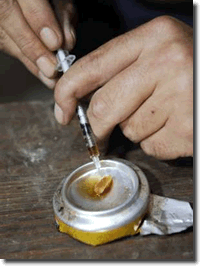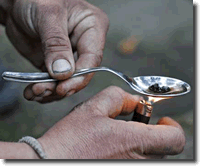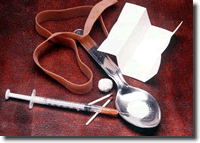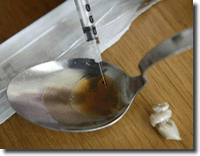
Heroin Addiction Statistics
- Heroin addiction statistics reveal that heroin is among the drug class known as "hard" drugs. The good news is that, among teenagers, heroin use is in decline. Among young adults, the number remains relatively stable, with a very slight increase. Even though heroin use remains stable - or is even going down - it is still important to recognize the fact that plenty of people still use heroin.
- The Centers for Disease Control (CDC) reports that teenagers reporting heroin use in their lifetime is declining. Amongst 12th graders, the number has come down from 3.0 percent in 2001 to 2.0 percent. The total number of teenagers that report using heroin in their lifetimes has dropped from 3.1 percent to 2.4 percent since 2001. This shows progress.
- According to heroin addiction statistics by the National Survey on Drug Use and Health (NSDUH), teenagers have reasonably easy access to heroin. 29.7 percent of 12th graders say that it is easy to obtain. Even 8th graders (12.6 percent) say that they can obtain heroin. However, there are other drugs, such as prescription drugs and marijuana that are much easier to obtain than heroin.
- It is encouraging to note that many teenagers recognize the risks of heroin. The NSDUH found that 87.8 percent of 12th graders agree that heroin substance abuse represents a "great risk." The fact that so many teenagers recognize the dangers of heroin use is encouraging, and could lead to further declines in teen drug use of heroin.
- Heroin addiction statistics show that amongst young adults and college students, heroin use is not seeing the decline it has in teenagers. Perhaps this older age group feels the risks are acceptable. A slight increase in heroin users in college students is seen - from 0.1 percent to 0.2 percent. Additionally, in young adults, those reporting that they have used heroin at least once in their lifetimes has increased from 1.7 percent in 2005 to 1.9 percent. It is a small increase, and one that shows that heroin substance abuse among young adults is stable and perhaps growing slightly.
- According to NSDUH information, in the last year about 91,000 persons over the age of 12 used heroin for the first time. Amongst recent first time heroin users, aged 12 to 49, the average age was 20.7. This indicates that many heroin users wait until they leave their teenagers years to begin using the drug.
- Heroin addiction statistics reports show that 3.8 million people (1.5 percent of the population above 12) say they have tried heroin at least once in their lifetimes.
- 560,000 people used heroin last year.
- 338,000 people used heroin last month.
- The rate of heroin lifetime heroin use is higher among those in prison (23.4 percent for State and 17.9 percent for Federal).
- Even though heroin use isn't terribly widespread, it still represents a significant threat. The devastating effects of heroin overdose and prolonged heroin use, along with its addicting nature, can be very damaging and put strain on loved ones of someone involved in heroin substance abuse.
- There are over 1.2 million "occasional" heroin users in the United States and over 200,000 people who could be classified as addicted to the drug according to current heroin addiction statistics.
- The average heroin addiction ingests between 150mg and 250mg of the drug per day.
- Heroin overdoses have caused more deaths than traffic accidents in the past several years.
- There are believed to be at least 700,000 people in the United States who need heroin addiction treatment but are not receiving it.
- According to a report from the United States Department of Health and Human Services, from the years spanning 1992 – 2002, the number of people injecting heroin declined, but the percentage of individuals smoking the drug increased by over 12%.
- In 2002 a heroin addiction statistics study by the National Survey on Drug Use and Health found that 53% of past year users of heroin had a dependence on the drug.
- Florida and California by far have the most heroin seizures by law enforcement each year (due to their physical location and prevalence of the drug trade in their states).
- During the 1990s, heroin addiction statistics reports that the number of self proclaimed past-month heroin users tripled from 68,000 to 208,000. Every year since, that number has continued to climb. The age of first time users has gotten increasingly lower, with more than 80 percent of them under the age of 26. About 150,000 people try the drug for the first time each year.
- After first time use, it takes only a few days of regular injection and a few weeks of regular smoking to develop a physical addiction to the drug. Heroin addiction statistics notes that once heroin addiction is a factor, the average addict will spend about $150 to $200 a day to maintain their habit while many will spend even more. In less than a year, few can be described as "functional" heroin addicts, that is, people who have a steady heroin addiction but still hold down a job or stay in school while paying rent and keeping up with other responsibilities. Instead, most heroin addicts are solely focused on maintaining their addiction and little else after the first year.
- The risks of heroin overdose or death due to negligent action under the influence of heroin is a serious one indeed. For example, 80 percent of heroin addicts get high with someone else, yet 80 percent of those who are found overdosing on heroin are found alone.
- Heroin addiction statistics reports that it is likely that more than 50 percent of accidental and unexpected deaths are due to heroin and morphine use. It is estimated that as many as 150,000 emergency room visits each year are due to heroin addiction or in some involved heroin use, equaling about 14 percent of all ER visits.









